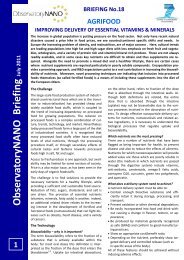Nanofillers - Improving Performance & Reducing Cost - Nanopinion
Nanofillers - Improving Performance & Reducing Cost - Nanopinion
Nanofillers - Improving Performance & Reducing Cost - Nanopinion
Create successful ePaper yourself
Turn your PDF publications into a flip-book with our unique Google optimized e-Paper software.
NANOFILLERS ‐ IMPROVING PERFORMANCE AND REDUCING COSTTechnology Readiness Levelslong‐term environmental implications.ObservatoryNANO Briefing September 20114Figure 5: TRL levels indicating the developmentlevel of filler technologies.ChallengesTechnologicalA major barrier for the wider commercialization ofnano‐enabled fillers is the poorer dispersion abilityof ultra‐fine grades or nanomaterials. In this regard,a suitable treatment or functionalisation ofnanoparticles or aggregates depending on the intendeduse is helpful. In addition, higher costs ofraw materials and treated grades are a disadvantage.An increase in the brittleness of nanocompositeswith high filling degrees has also been observed.Further key challenges include exfoliationand dispersion of nanomaterials.Environmental, Health & Safety ImplicationsNanomaterials in powder form can easily becomeairborne. For fillers, this applies at the stage ofboth material production and of composite productionand processing. Nanomaterials used asfillers include both high volume production materialsfor which there is already considerable historyof toxicity research (e.g. PCC, silica), as well as newmaterials (e.g. CNT, graphene) for which potentialhazard has been highlighted and is currently subjectto extensive investigation. Excessive exposureto any of these nanomaterials has potential to resultin risks to health and the environment. Whilstfor many of these materials (e.g. PCC), previousexposures have been observed with no significantill effects, for some new materials (e.g. CNT), a potentialfor much greater toxicity has been identified,particularly with respect to inhalation exposure.In line with the precautionary principle, appropriateoccupational health and safety mechanismsshould therefore be in place in order to preventexposure. Life cycle assessments, includingrecycling processes, are also required to preventSummary• <strong>Nanofillers</strong> are characterized by their particlesize, specific surface area, particle geometry andchemical functionalisation.• Smaller filler particle sizes provide new functionalitiessuch as improved mechanical strengthand control of rheological properties.• The high specific surface area of nanomaterialsprovides a route towards novel properties anddecreased filling levels.• Needle‐like nanofillers have a stronger impacton the mechanical properties.• Hybrid materials provide a route towards fullydispersed nanomaterials and superior nanocomposites.• Critical issues are exfoliation and dispersion ofnanomaterials, and a poorer processability.• Due to some EHS concerns, appropriate occupationalhealth and safety mechanisms should bein place in order to prevent exposure.ContactMichael Gleiche, VDI Technologiezentrum GmbH,gleiche@vdi.deReferences1 Market Report “Fillers” (Marktstudie Füllstoffe (UC‐805)), CeresanaResearch, 2007.2„Reinforcing mechanisms on the macro‐, micro‐ and nanoscale inheterogeneous polymer materials“ (Verstärkungsmechanismen aufMakro‐, Mikro‐ und Nano‐Längenskalen in heterogenenPolymerwerkstoffen), Habilitation thesis, Gyeong‐Man Kim, Universityof Halle3Yang Li and Arthur J. Ragauskas, Advances in Diverse Industrial Applicationsof Nanocomposites, ISBN 978‐953‐307‐202‐9, InTech, March20114http://www.freepatentsonline.com/20040253164.pdf5„MICRO‐NANO POROUS MATERIALS FOR HIGH PERFORMANCE THER‐MAL INSULATION“ CSTB French Building Research Institute, 2nd InternationalSymposium on Nanotechnology in Construction, Bilbao 2005.6http://www.iri.net.in/conference/images/stories/pdf/IRI/Presentation/Technical/18/3/Laurent.Guy.EA.090.pdf7“Precipitation of Barium Sulphate Nanoparticles in Microemulsion:Experiments and Modelling”, PhD thesis of Dendy Adityawarman,University of Magdeburg.8G. Momen and M. Farzaneh, Rev.Adv.Mater.Sci. 27 (2011), 1‐13.9http://belgianpolymergroup.be/Flame/Beyer.pdf10J.M. Makar and J.J. Beaudoin, Proceedings of 1st InternationalSymposium on Nanotechnology in Construction June 23‐25, 2003,Paisley, Scotland11Raki, L. et al, Materials 2010, 3, 918‐94212J. V. Accorsi, KGK Kautschuk Gummi Kunststoffe 54. Jahrgang, Nr.6/200113Lorenz Ratke, Beton‐ und Stahlbetonbau 103 (2008), Heft 414http://www.electronics.ca/presscenter/articles/1404/1/Global‐Nanocomposites‐Market‐to‐Reach‐13‐Billion‐Pounds‐‐by‐2015/Page1.html15http://www.roskill.com/reports/industrial‐minerals/pcc/16http://www.shengdatechinc.com/files/09‐07‐09%20SDTH%20profile.pdf17http://www.wacker.com/cms/media/documents/investorrelations/factbook2010.pdf18"Global Carbon Nanotube Market ‐ SWCNT, MWCNT, Technology,Applications, Trends & Outlook (2011 ‐ 2016)" published by MarketsandMarkets(http://www.marketsandmarkets.com)19http://www.marketresearch.com/product/display.asp?productid=2873964





